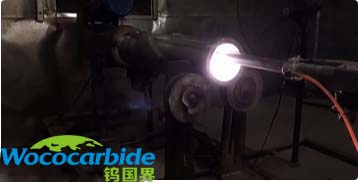

current position:Information and data>Application of Plasma Surfacing Technology
The main form of plasma surfacing material is powder. Because the chemical composition of the powder can be changed flexibly, the composition and properties of the plasma surfacing layer are easier to adjust than other surfacing methods using wire. The most commonly used powder materials in plasma surfacing are self-fluxing alloy powders. This is a kind of alloy powder with its own flux function. It does not need to add flux during deposition and surfacing. The alloy itself has the functions of deoxidation, slag formation and wettability improvement. In the process of use, two or more different types of powders (one of which can be a hard phase) can also be mechanically mixed in a certain proportion to obtain a surfacing alloy powder with another composition and performance, in order to To quickly obtain an alloy of a certain property, this method is also often used in experiments. The dilution rate of the surfacing layer is one of the most important indicators reflecting the characteristics of a surfacing method. The size of the dilution rate directly affects the final composition and metallographic structure of the surfacing layer, and ultimately determines the performance of the surface surfacing layer. Taking advantage of the good controllability of the heat source in plasma surfacing, when using self-fluxing alloy powder for surfacing, the dilution rate of the base metal to the surfacing layer can be controlled within a very low range, such as 3 to 7%. A lower dilution rate can be obtained if the reverse polarity plasma surfacing method is used. However, a too low surfacing dilution rate, such as below 3%, is difficult to guarantee on the entire cladding interface of conventional components, and bears the risk of non-fusion defects. The deposition efficiency of plasma powder surfacing refers to the mass percentage of the deposited metal and the powder material used in the surfacing process, which reflects the utilization rate of the surfacing material. The size of the deposition efficiency is directly related to the production cost of plasma surfacing (especially when surfacing expensive powder alloys). The deposition efficiency of plasma surfacing is generally around 80-95%, and the deposition rate can reach more than 95% under certain conditions. The deposition rate refers to the quality of the effectively deposited surfacing alloy per unit time. The latest data shows that the deposition rate of plasma powder surfacing can reach 12.5 kg/h or higher.

(1) Building materials machinery: brick and tile factories, stirring knives, stirring cages, counter-rolling, hammer breaking, and cage breaking. Cement plants, trays, spires, teeth, liners, jaws, rock breakers, hammers, drainage blades, squeeze rollers, grinding rollers, excavators, shovel teeth.
(2) Mining industry: repairing of coal mines, chutes, electric bucket teeth and drill bits.
(3) Steel mill: big bell, small bell, funnel.
(4) Sugar mills: mixing and crushing in paper mills, construction, refractory factories and other enterprises.
(5) Agriculture: ploughing coulters, corn stalk crushing.
(6) Other industries: repairing various wear-resistant parts can achieve ideal results. Features: high hardness, high wear resistance, abrasion resistance, etc. Good weldability. Resists the wear of rock sand and abrasive particles, prolonging the service life of the equipment by more than 10 times.
Hot information

